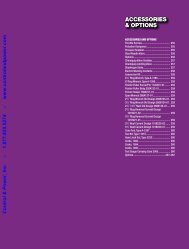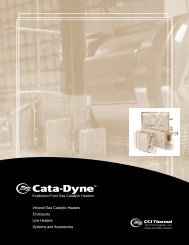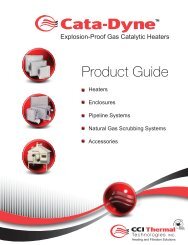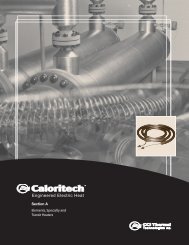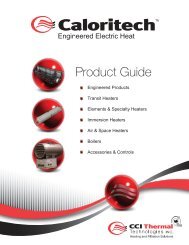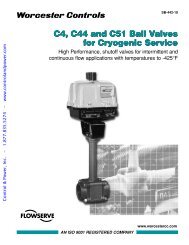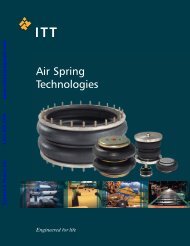Gestra Products Technical - Control And Power
Gestra Products Technical - Control And Power
Gestra Products Technical - Control And Power
You also want an ePaper? Increase the reach of your titles
YUMPU automatically turns print PDFs into web optimized ePapers that Google loves.
Testing Steam Traps<br />
Like any other industrial valve steam traps are subject to wear and<br />
their correct functioning can be impaired by precipitated solids and dirt<br />
deposits.<br />
To assess the performance of a steam trap the following questions have<br />
to be answered:<br />
• Does the steam trap work properly?<br />
• If not, does the faulty trap cause loss of steam<br />
(leakage) or banking-up of condensate (obstructed discharge<br />
passage)?<br />
Faulty steam traps are a major source of waste in a steam distribution<br />
system. A trap that is blowing live steam is the worst offender, but traps<br />
that are plugged or stuck closed can also be costly.<br />
The decreased plant efficiency due to loss of energy and additional<br />
make-up water results in lost production. Furthermore, an increase<br />
of pressure is liable to arise in condensate systems which will lead to<br />
difficulties at all locations where condensate is discharged.<br />
The magnitude of such a steam loss depends on the cross-sectional<br />
area of the leak and, at the same time, the amount of discharged<br />
condensate. Locations where only small amounts of condensate are<br />
formed and discharged, e. g. drainage points in steam lines and tracing<br />
systems, are particularly problematical. On the other hand, locations<br />
where relatively large amounts of condensate are discharged will not<br />
give rise to considerable loss of live steam because of the presence of a<br />
large volume of liquid.<br />
Steam traps which are obstructed or stuck closed do not cause<br />
loss of energy and/or water but reduce – to a greater or lesser extent<br />
– the efficiency of heat-transfer equipment and steam users. <strong>And</strong><br />
waterhammer caused by condensate banking-up leads to considerable<br />
physical damage in steam and condensate systems.<br />
Experience shows that installations where no regular trap testing and<br />
servicing takes place have a failure rate of defective steam traps in<br />
the order of 15 – 25 %. Regular maintenance and trap testing, which<br />
should be carried out at least once a year, can strongly reduce the<br />
failure rate to 5 %.<br />
Test Systems<br />
Steam traps can be tested during operation by using sightglasses,<br />
ultrasonic listening devices or level meters.<br />
Sightglasses (Vaposcopes Type VK 14, VK 16) provide an effective<br />
means of observing the flow of liquids in pipework. They are installed<br />
upstream of the traps, and allow the assessment of the traps by making<br />
their operation visible.<br />
Level meters use conductivity readings to monitor steam trap<br />
performance. A test chamber with an integral level electrode is installed<br />
upstream of the trap to detect any defective steam trap. The corresponding<br />
output signal is displayed by the Remote Test Unit NRA 1-3x<br />
(remote monitoring).<br />
The system VKE can monitor all types and makes of steam traps to<br />
detect loss of live steam. The correct operation of RHOMBUSline steam<br />
traps type BK 45/46, MK 45, UBK 46 can be verified by using the<br />
compact-type level probes NRG 16-19, NRG 16-27 and NRG 16-28. The<br />
test station NRA 1-3x will evalute the data coming from the system VKE.<br />
Another way to test traps is to use an ultrasonic listening device<br />
which detects the sound produced by steam flowing through the traps.<br />
Depending on the test system used the sound sensed by the device<br />
is either graphically represented in the form of a curve (VKP 40) or<br />
indicated by the deflection on the scale of a meter (VKP 10).<br />
When using the VKP 10, the field data specialist has to assess the<br />
indicator deflection and, consequently, the operation of the steam trap.<br />
The VKP 40, however, can directly track leaks associated with faulty<br />
steam traps and provides comprehensive reporting and a complete trap<br />
survey history.<br />
Annual costs caused by steam loss<br />
Number of steam traps installed<br />
Annual failure rate<br />
(Empirical value with first check approx. 15 – 25 %)<br />
A Number of defective steam traps<br />
B Steam loss per steam trap (kg/h)<br />
C Annual operating hours<br />
D Annual steam loss (kg) A x B x C<br />
=<br />
E Cost of steam per ton<br />
F Annual loss in EURO D /1000 x E =<br />
Example<br />
A Number of defective steam traps 10<br />
B Steam loss per steam trap 3 kg/h<br />
C Annual operating hours 8000 h<br />
D Annual steam loss 240000 kg<br />
E Cost of steam per ton 60 Euro/t<br />
F Annual loss 14,400.– Euro<br />
By the way:<br />
A new steam trap costs – depending on the end connection<br />
– only approx. e 150 to e 200.<br />
2<br />
A1



